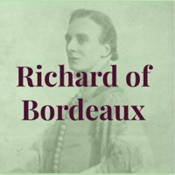
Explore this Show
Overview
Synopsis
Richard of Bordeaux is the king of England. Only 19 years old--and having been a king for 10 of those years-- he is ready to cast off the council of uncles and advisors and assert his independence as a ruler. With his Queen Anne at his side, Richard slowly and deliberately eliminates the influence of his three uncles (York, Lancaster, and Gloucester) while putting trusted friends into key government positions. He is a young king with a world of possibilities in front of him. But Richard, even as he outsmarts and outmaneuvers his adversaries, is pulled into a political quagmire. After his beloved wife dies, he becomes the Richard II of the history books: immature, vindictive, and self-indulgent. With this course of his character, there can be only one tragic conclusion.
Richard of Bordeaux was an instant success at London’s New Theatre in 1933, making director John Gielgund (who also played the titular role) a dominant theatrical force. Inspired by Shakespeare’s Richard II, Elizabeth Mackintosh throws off typical portrayals and creates a sympathetic portrayal of a young man still searching for how to be a king.
Show Information
- Book
- Elizabeth MacKintosh
- Category
- Play
- Age Guidance
- Youth (Y)/General Audiences (G)
- Number of Acts
- 2
- First Produced
- 1933
- Genres
- Drama, Historical/Biographical
- Settings
- Period
- Time & Place
- England, France, 1385-1399
- Cast Size
- large
- Orchestra Size
- None
- Dancing
- None
- Licensor
- None/royalty-free
- Ideal For
- College/University, Community Theatre, Large Cast, Mostly Male Cast, Professional Theatre, Regional Theatre, Star Vehicle Male, Includes Late Teen, Young Adult, Adult, Mature Adult, Elderly Characters
Context
Plot
Characters
| Name | Part Size | Gender | Vocal Part |
|---|---|---|---|
|
Lead |
Male |
Non-singer |
|
|
Lead |
Female |
Non-singer |
|
|
Lead |
Male |
Non-singer |
|
|
Lead |
Male |
Non-singer |
|
|
Supporting |
Male |
Non-singer |
|
|
Supporting |
Male |
Non-singer |
|
|
Supporting |
Male |
Non-singer |
|
|
Supporting |
Male |
Non-singer |
|
|
Supporting |
Male |
Non-singer |
|
|
Supporting |
Male |
Non-singer |
|
|
Supporting |
Male |
Non-singer |
|
|
Supporting |
Female |
Non-singer |
|
|
Supporting |
Female |
Non-singer |
|
|
Supporting |
Male |
Non-singer |
|
|
Supporting |
Male |
Non-singer |
|
|
Supporting |
Male |
Non-singer |
|
|
Supporting |
Male |
Non-singer |
|
|
Featured |
Either Gender |
Non-singer |
Songs
A song with an asterisk (*) before the title indicates a dance number; a character listed in a song with an asterisk (*) by the character's name indicates that the character exclusively serves as a dancer in this song, which is sung by other characters.
Monologues
Scenes
Key Terms
Formally giving up the throne and royal titles.
A genre of play that is based on the narrative of true historical events and people, often considered a subgenre of tragedy.
Description of material not protected by copyright law.
The fees paid to the originator (playwright, composer, etc.) of a work, as a part of or in addition to the licensing fees paid to the publisher or licensor.
Videos
Sorry! We do not currently have videos for this guide.
Quizzes
Sorry! We do not currently have quizzes for this guide.
Themes, Symbols & Motifs
Sorry! We do not currently have learning modules for this guide.
Quote Analysis
Sorry! We do not currently have learning modules for this guide.
